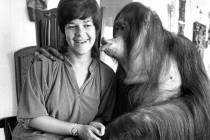Face forward, shoulders back, head up, smile! (How do I look?)
Many years passed before I became comfortable with public speaking and television appearances. OK, it has taken decades.
Recently, I read Christine Jahnke’s new book “The Well-Spoken Woman” only to discover I’m still doing things wrong. On her list of Ten Most Outrageous Things to Wear on Camera, I have worn three of them on “Nevada Week in Review.” And not so long ago.
“Pleats will make you look like you’ve covered yourself with a circus-tent,” the speech coach wrote. “Candy-red lipstick makes you look like you’re headed to an audition for a daytime soap.” (I didn’t do the first, but I did do the second.)
The book was funny and helpful, just like the woman herself. Her book is a reminder of some of the great woman speakers of all time — Texas Rep. Barbara Jordan, Texas Gov. Ann Richards, former Sen. Elizabeth Dole of North Carolina, philanthropist Melinda Gates, poet Maya Angelou, motivational speaker Suze Orman, Secretary of State Hillary Clinton and former Secretary of State Madeleine Albright. She wrote about not just how they said it, but what they said.
While the book is designed for women in politics, Jahnke’s advice works for lawyers and businesswomen. She also hopes it’s helpful to women giving comments at a baby shower or a book club.
Jahnke taught first lady Michelle Obama a better way to stand while giving a speech — something I am going to adopt in my next presentation. The champion stance consists of one foot in front of the other, weight on the back leg, face forward, head up, shoulders drop back and weight moves forward. Then smile.
Jahnke (pronounced “Yon-key”) spends a lot of time on how to use your voice, so a natural question is: Should former Rep. Dina Titus lose her Georgia twang and should Rep. Shelley Berkley soften her New York accent?
In the book Jahnke advised, “If your accent is pronounced, consult a professional voice coach to gain tips on diction, pronunciation and diction.”
When asked specifically about Titus and Berkley, Jahnke said, “I actually think it’s a good thing the way they sound because it’s who they are, and authenticity is important.” At this point in their careers, for either to undergo a dramatic change in their speaking style would mean they weren’t true to themselves, she said.
She pointed to Ann Richards’ Texas twang and Barbara Jordan’s Kennedyesque Boston accent.
Yet, I heard no regional accent in Jahnke’s voice. She began her career in Minnesota, but when she worked on TV, she rid herself of that accent because most television reporters and anchors seek a neutral accent.
Since 1996, Jahnke has been backstage at the Democratic National Convention coaching speakers about how to do their best on national television. During the 2008 campaign, she coached the surrogates who would be speaking on Hillary Clinton’s behalf on message training and speech training. “Obviously I come to this with a point of view,” she said.
If you think this book is unnecessary in today’s world, she mentioned a study of women students at Yale Law School who said they were less likely to speak up in class than the men. Ninety percent of the women said men are more confident with public speaking, even making a minor point.
She warned in her section on the hostile media that easy questions can throw you off balance. So I asked one.
Was there anything else she wanted to say?
She paused. “I’m supposed to summarize my points,” she said slowly, collecting her thoughts. Then she launched into the three elements of success for giving speeches. Have a signature style. Be yourself. Be self-assured.
“The Well-Spoken Woman” contains pointers men could use, too, like Chapter 3.
The Voice: Your Weakest Link? (Jon Ralston, do you hear me now?)
Jane Ann Morrison’s column appears Monday, Thursday and Saturday. Email her at Jane@reviewjournal.com or call her at
(702) 383-0275. She also blogs at
lvrj.com/blogs/Morrison












